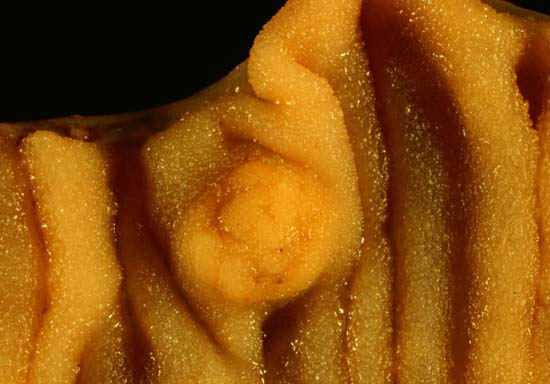- Carcinoid
DiseaseDisorder infobox
Name = Carcinoid
ICD10 = ICD10|E|34|0|e|20
ICD9 = ICD9|259.2
ICDO = ICDO|8240|3

Caption = Picture of a carcinoid tumour that encroaches into lumen of thesmall bowel (centre of image). Pathology specimen. The prominent folds areplicae circulares , a characteristic of small bowel.
OMIM = 114900
MedlinePlus = 000347
eMedicineSubj = med
eMedicineTopic = 271
DiseasesDB = 2040
MeshID = D002276Carcinoid (also carcinoid tumour or carcinoid tumor) is a slow-growingcite journal |author=Maroun J, Kocha W, Kvols L, "et al" |title=Guidelines for the diagnosis and management of carcinoid tumours. Part 1: The gastrointestinal tract. A statement from a Canadian National Carcinoid Expert Group |journal=Curr Oncol |volume=13 |issue=2 |pages=67–76 |year=2006 |month=April |pmid=17576444 |pmc=1891174 |doi= |url=http://www.current-oncology.com/index.php/oncology/article/view/84/53;] but
malignant type ofneuroendocrine tumour , originating in the cells of theneuroendocrine system . In 2000, theWorld Health Organization redefined "carcinoid", but this new definition has not been accepted by all practitioners.cite web |url=http://www.cancer.org/docroot/CRI/content/CRI_2_4_1X_What_are_gastrointestinal_carcinoid_tumors_14.asp |title=ACS :: What Is a Gastrointestinal Carcinoid Tumor? |format= |work= |accessdate=] This has led to some complexity in distinguishing between carcinoid andneuroendocrine tumor s in the literature.Presentation
Carcinoid tumours are
apudomas that arise from theenterochromaffin cell s throughout the gut.Over two-thirds of carcinoid tumors are found in the
gastrointestinal tract .cite journal |author=Modlin IM, Lye KD, Kidd M |title=A 5-decade analysis of 13,715 carcinoid tumors |journal=Cancer |volume=97 |issue=4 |pages=934–59 |year=2003 |month=February |pmid=12569593 |doi=10.1002/cncr.11105 |url=http://dx.doi.org/10.1002/cncr.11105]They are most commonly found in the
foregut (35.6% cases) withlung ,bronchus andtrachea constituting 27.9% cases from where they rarelymetastasis e (except in case of pancreas). The next most common affected area is the small intestine especially the midgut (32.1% cases) with the highest proportion fromileum at 14.9% of all cases [as per the PAN-SEER data (1973-1999)] .Some sources list the appendix as the most common site.cite web |url=http://www.cancer.gov/Templates/db_alpha.aspx?CdrID=44233 |title=Definition of carcinoid - NCI Dictionary of Cancer Terms |format= |work= |accessdate=]
In cases of metastases it can lead to
carcinoid syndrome . This is due to the production ofserotonin ,Fact|date=July 2007 which is released into the systemic circulation, which leads to symptoms of cutaneous flushing,diarrhea ,bronchoconstriction and right-sidedcardiac valve disease.History
They were first characterized in 1907 by
Siegfried Oberndorfer , a Germanpathologist at theUniversity of Munich , who coined the term "karzinoide", or "carcinoma-like", to describe the unique feature of behaving like abenign tumour despite having amalignant appearance microscopically. The recognition of their endocrine-related properties were later described by Gosset andMasson in 1914, and these tumours are now known to arise from the enterochromaffin (EC) and enterochromaffin-like (ECL) cells of the gut.Some sources credit Lubarsch with the discovery.cite journal |author=Kulke MH, Mayer RJ |title=Carcinoid tumors |journal=
N. Engl. J. Med. |volume=340 |issue=11 |pages=858–68 |year=1999 |month=March |pmid=10080850 |doi= |url=http://content.nejm.org/cgi/pmidlookup?view=short&pmid=10080850&promo=ONFLNS19]ymptoms
Most carcinoids are asymptomatic through the natural lifetime and are discovered only upon surgery for unrelated reasons; these are called "coincidental carcinoids". But all carcinoids are considered to have malignant potential.
About 10 percent of carcinoids secrete excessive levels of a range of
hormone s, most notablyserotonin (5-HT), causing:
* Flushing
*Diarrhea
* Wheezing
* Abdominal cramping
*Peripheral edema This constellation of symptoms is called "
carcinoid syndrome " or (if acute) "carcinoid crisis". Occasionally,haemorrhage or the effects of tumour bulk are the presenting symptoms. The most common originating sites of carcinoid is the small bowel, particularly the ileum; carcinoid tumors are the most common malignancy of the appendix, and ovarian origin, though reported, is rare.Fact|date=July 2007Treatment
Surgery , if feasible, is the only curative therapy. If the tumor has metastasized (most commonly, to theliver ) and considered incurable, there are some promising treatment modalities, such as radiolabeledoctreotide ,Fact|date=July 2007, for arresting the growth of the tumors and prolonging survival in patients with liver metastases, though these are currently experimental.Chemotherapy is of little benefit and is generally not indicated.Octreotide (asomatostatin analogue) may decrease the secretory activity of the carcinoid.Carcinoid tumors are the most common malignant tumor of the appendix, but they are most commonly associated with the small intestine, and they can also be found in the
rectum andstomach . They are known to grow in the liver, but this finding is usually a manifestation of metastatic disease from a primary carcinoid occurring elsewhere in the body. They have a very slow growth rate compared to most malignant tumors.Goblet Cell Carcinoid
This is considered to be a hybrid between an
exocrine andendocrine tumour derived from crypt cells of the appendix. Histologically, it forms clusters of goblet cells containing mucin with a minor admixture of Paneth cells and endocrine cells. The growth pattern is distinctive: typically producing a concentric band of tumour nests interspersed among themuscle andstroma of the appendiceal wall extending up the shaft of the appendix. This makes the lesion difficult to suspect grossly and difficult to measure. Small tumour nests may be camouflaged amongst the muscle or in periappendiceal fat;cytokeratin preparations best demonstrate the tumour cells;mucin stains are also helpful in identifying them. They behave in a more aggressive manner than do classical appendiceal carcinoids. Spread is usually to regional lymph nodes,peritoneum , and particularly the ovary. They do not produce sufficient hormonal substances to cause the carcinoid or other endocrine syndromes. In fact, they more closely resemble exocrine than endocrine tumors. The term 'crypt cell carcinoma' has been used for them, and though perhaps more accurate than considering them carcinoids, has not been a successful competitor. The ICD-O code for goblet cell carcinoid is 8243/3.Fact|date=July 2007ee also
*
Carcinoid syndrome
=AdditionalReferences
External links
* [http://www.caringforcarcinoid.org Caring for Carcinoid Foundation]
* http://www.netumoradvisor.org
* http://www.carcinoid.com
* [http://www.carcinoid.org The Carcinoid Cancer Foundation]
Wikimedia Foundation. 2010.
